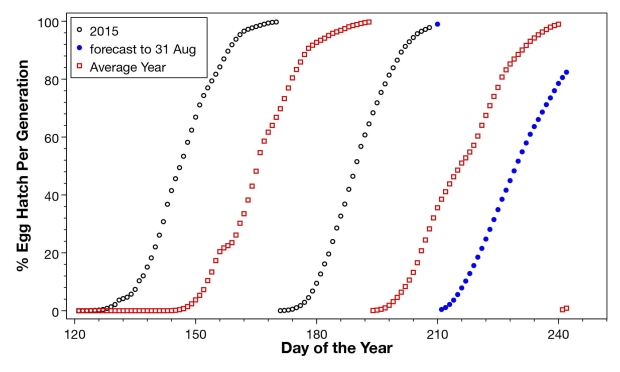Codling moth, the key apple pest in Washington state, will develop through three to four generations in Eastern Washington this year — one generation more than usual — because of the unusually hot weather.
Washington State University entomologist Dr. Vince Jones, has issued the following report.
This year is the hottest year on record at WSU’s Tree Fruit Research and Extension Center in Wenatchee since 1931, when record keeping began. The current codling moth degree-day (DD) accumulation on July 28 at TFREC (2274 DD) is 16.4% higher than in 2014 (second hottest year on record) and 10.6 % higher than the previous hottest year (1958).
The average DD accumulation over 1931-2015 was 1661 DD at this point, so we have accumulated 613 DD (36.9%) more than the average! Examining the DD accumulations throughout the eastern part of the state shows we are 7-13 days ahead of those in 2014.
Long-range forecasts show that before diapause induction is complete on August 18 (diapause is triggered solely by photoperiod) several sites in the warmer parts of the state (e.g., Desert Aire, Mattawa, Parker, WSU Sunrise, and WSU Tri-Cities) will have accumulated more than 2800 DD, which will allow a substantial number of the second summer generation to skip diapause and will result in a fourth adult flight (the overwintering adults + 3 summer generations) and larvae being able to complete a partial third summer generation in the warmer areas.
The difference between an average year and the current record-breaking one can be seen in the graph below.
The difference between an average codling moth egg hatch year and the current record-breaking one, marked in blue. (Courtesy Washington State University Tree Fruit Research Center Entomologists)
If you are using mating disruption, these extra flights should not cause problems unless you have a large external population migrating into your orchard. The mating disruption dispensers should not run out even though this is a hotter year.
If you are not using mating disruption, these late flights may cause fruit damage and need to be controlled if populations in your orchard are high. Controls for this generation need to be started by 2345 DD. Make sure you pay close attention to the pre-harvest intervals for the pesticide used and follow closely model predictions on das.wsu.edu to deal with the third summer generation larvae.







Leave A Comment